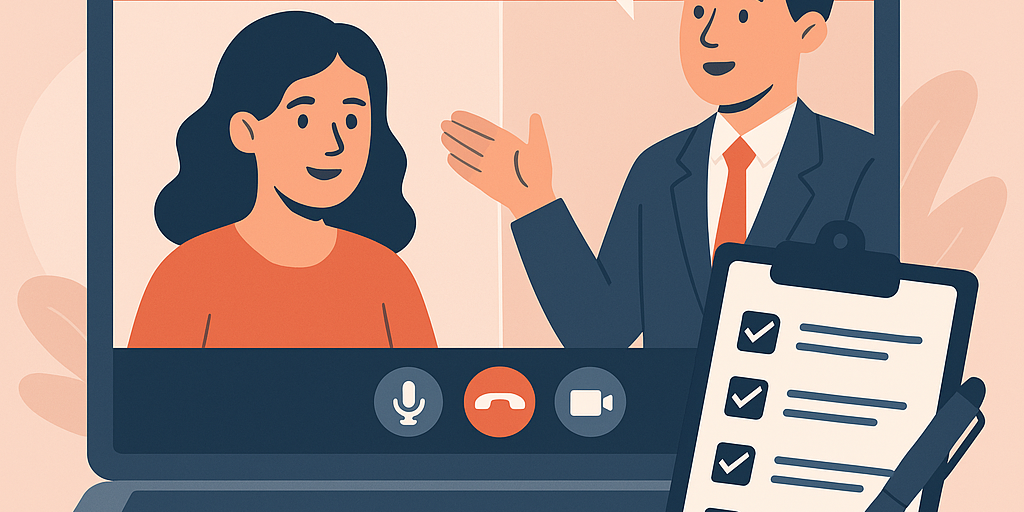The world of recruitment has rapidly evolved, and video interviews have become a cornerstone of modern hiring. They offer flexibility, save time and resources, and allow you to connect with candidates from anywhere in the world. But just like any tool, video interviews require a thoughtful approach to be truly effective. Are you making the most of your virtual hiring process?
Level up your virtual game: video interview best practices
Think of a video interview like an in-person meeting, just online. Preparation is crucial for both you and the candidate. Here are some best practices to ensure a smooth and productive process:
- Clear communication is key: before the interview, provide the candidate with all the necessary information: the platform you’ll be using, the expected duration, and any specific instructions. Sending a calendar invite with a clear link is a simple yet effective step.
- Test your tech: nothing is more disruptive than technical glitches. Before each interview, double-check your internet connection, camera, and microphone. Ensure your chosen platform is working correctly.
- Professional environment matters: choose a quiet space with good lighting and a neutral background. Avoid distractions and ensure your focus is solely on the candidate.
- Structured interviews: prepare a list of questions beforehand to ensure consistency across all candidates. This helps you compare applicants fairly and objectively.
- Engage actively: just like in a face-to-face interview, pay attention to the candidate’s responses, maintain eye contact (look at the camera!), and show genuine interest. Nod, smile, and use verbal cues to signal your engagement.
Pro tip: always have a plan-b in case of technical issues. A good practice is to inform about it the candidate before the meeting, so they are aware what they should do, if they have some issues.
Don’t fall into these traps: common video interview errors
Even with the best intentions, it’s easy to stumble in the virtual realm. Here are some common mistakes to watch out for:
- Poor technical setup: as mentioned before, technical issues can derail an interview. Not testing your equipment or using an unstable internet connection can lead to frustration for both parties.
- Distractions galore: conducting an interview in a noisy environment or getting interrupted frequently shows a lack of respect for the candidate’s time.
- Reading from a script: while having prepared questions is essential, reading them verbatim can make the interview feel robotic and impersonal. Be natural and engage in a genuine conversation.
- Forgetting the “human” element: it’s easy to focus solely on the questions and answers in a virtual setting. Remember to build rapport with the candidate, just as you would in person. A brief, friendly chat at the beginning can help put them at ease.
- Not providing clear next steps: leaving the candidate in the dark about the hiring timeline can lead to a negative experience. Clearly outline the next steps in the process.
Making a great impression: the candidate experience in video interviews
The candidate experience is paramount, regardless of the interview format. A positive experience not only attracts top talent but also strengthens your employer brand. Here’s how to make your video interviews candidate-centric:
- Provide clear instructions: ensure candidates know exactly what to expect, including the platform, duration, topics, and any pre-interview tasks.
- Keep it user-friendly: choose a video conferencing platform that is easy for candidates to use, without requiring complex downloads or setups.
- Be punctual: just as you would for an in-person interview, be on time for the video call. If there’s an unexpected delay, communicate it to the candidate promptly.
- Create a welcoming atmosphere: start with a friendly greeting and try to create a comfortable and relaxed environment. Ask them how they are doing and engage in some light conversation before diving into the formal questions. Remember, most likely they will be stressed – so it’s good to help them relax a little bit.
- Be respectful of their time: stick to the agreed-upon time limit and ensure the interview flows smoothly.
- Offer opportunities for questions: always leave time at the end for the candidate to ask their own questions. This shows that you value their engagement and interest.
- Prompt feedback: while you might not be able to provide immediate feedback, aim to communicate the next steps and timeline as soon as possible.
Assessing language skills remotely with video interviews
For many roles, especially in today’s globalized world, language proficiency is a critical skill. Video interviews offer a unique opportunity to assess a candidate’s communication abilities. Here’s how you can effectively check language knowledge during a virtual interview:
- Integrate language-specific questions: depending on the role’s requirements, weave in questions that naturally require the candidate to speak in the target language. For example, you could ask them to describe their experience working with international teams/clients or to explain a complex concept in a specific language.
- Example: If you’re hiring for a sales role, you could ask the candidate, “Can you tell me about your experience managing client accounts in France?”).
- Observe communication style: pay attention to their fluency, grammar, pronunciation, and overall clarity when they speak. Do they express themselves confidently and accurately?
- Use real-life scenarios: present hypothetical situations that require the candidate to use the target language in a practical context.
- Example: For a customer support role, you could say, “Imagine a client calls with a problem with their order. How would you handle this situation?”
For a more objective and comprehensive assessment of language skills, consider using a dedicated tool like Focus Audit Tool. Our platform allows you to verify language proficiency in over 30 languages through online audits. This can be seamlessly integrated into your hiring process, either before or after the initial video interview, providing you with a standardized and reliable measure of a candidate’s language abilities.
Embracing the power of virtual connections and smart assessment
Video interviews have revolutionized recruitment, offering unparalleled flexibility and reach. By adopting these best practices and consciously avoiding common pitfalls, you can significantly enhance your virtual hiring success and create a positive experience for every candidate. But to truly optimize your process and ensure you’re hiring the best talent, especially when language skills are crucial, consider integrating a powerful tool like Focus Audit Tool.
Imagine a hiring process where you can quickly and efficiently verify the language proficiency of your candidates without dedicating valuable interview time to direct language assessment. With Focus Audit Tool, candidates can independently complete comprehensive language audits that go beyond just speaking skills, evaluating writing, reading, and listening abilities as well. Our audits are meticulously reviewed by experienced language teachers, guaranteeing an accurate and reliable evaluation of each candidate’s capabilities.
Furthermore, Focus Audit Tool can be seamlessly implemented as a pre-interview screening step. This allows you to filter candidates who don’t meet the required language proficiency early on, saving your recruitment team countless hours that would otherwise be spent interviewing unsuitable applicants. By integrating Focus Audit Tool into your video interviewing strategy, you not only streamline your hiring process and make it more efficient but also gain the confidence of knowing you’re selecting candidates with the precise language skills your organization needs to thrive in today’s global landscape. Embrace the power of virtual connections, enhanced by the smart assessment capabilities of Focus Audit Tool, and unlock a new level of hiring success.





